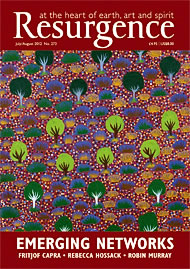Over the past 30 years, a new systemic understanding of life has been emerging at the forefront of science. At the core of this new understanding, there is a change of metaphor from seeing the world as a machine to understanding it as a network. The network has been recognised as the basic pattern of organisation in all living systems. Ecosystems are understood in terms of food webs (i.e. networks of organisms); organisms are networks of cells; and cells are networks of molecules. And then there are the social networks in human societies, which are networks of communications.
The paradigm shift from the machine to the network is taking place today not only in science but also in society at large and throughout a newly emerging global culture in which social and technological networks have become all important. Within a few years, the internet became a powerful global network of communications, and many large corporations today are organised as decentralised networks of much smaller units.
Similar networks exist among NGOs. Indeed, ‘networking’ has been one of the main activities of political grass-roots organisations for many years. The environmental movement, the human rights movement, the feminist movement, the peace movement and many other political and cultural grass roots movements have organised themselves as networks that now transcend national boundaries.
In fact, we can identify three centres of power in today’s world: government, business, and the network of NGOs that form a new global civil society. In my opinion, networking is most widespread in civil society, a little less in business, and least in government.
Some time ago, I participated in a seminar in Washington, DC, organised by the State Department, about “policymaking in an interconnected world”. During this seminar, I heard many complaints about how difficult it is to introduce the practice of networking and of forming partnerships into Washington’s political culture, which consists of huge, hierarchical bureaucracies. At the centre of these discussions was the question, “Who exerts power in a network?”, since power is what politicians are most concerned about.
To understand how power works in social networks, we need to distinguish between two kinds of power: power as domination of others, and power as empowerment of others. The most effective social organisation for power as domination is the traditional hierarchy, and power as empowerment is the network.
In a social network, people are empowered by being connected to the network. In such a network, or community, the success of the whole community depends on the success of its individual members, while the success of each member depends on the success of the community as a whole. Any empowerment of individuals, due to increased connectedness in the network, will therefore also empower the entire network. In such a social network, the hubs with the richest connections are centres of power. They are sought out as centres of authority because they connect large numbers of individuals and organisations to the network. And in so doing, they empower those very individuals as well as the network as a whole.








